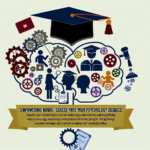
Introduction
In today’s rapidly evolving educational landscape, the role of family involvement has emerged as a cornerstone of academic excellence. The Collaborative Classroom: How Family Involvement Leads to Educational Excellence is more than just a buzzword; it represents a transformative approach to learning that engages families as partners. Imagine a classroom where parents, educators, and communities cohesively work together, ensuring each child not only learns but thrives. This article will explore the essential facets of this collaboration, showcasing how family involvement can elevate educational outcomes to unprecedented heights.
Understanding the Need for Family Involvement
The Shifting Paradigm of Education
The traditional view of education is swiftly giving way to a more inclusive model that recognizes the critical role families play. Parents are no longer mere spectators; they are active participants in their children’s educational journeys. Research consistently shows that when families engage with schools, student motivation, behavior, and overall academic performance are positively impacted.
The Benefits of a Collaborative Classroom
- Enhanced Academic Performance: Students with involved families perform better academically. The Collaborative Classroom: How Family Involvement Leads to Educational Excellence is fundamentally rooted in this principle.
- Improved School Environment: A strong partnership between families and schools fosters a sense of community, encouraging positive behavior and reducing dropout rates.
- Empowerment for Parents: When families are educated about the curriculum and school policies, they feel empowered to advocate for their children.
Key Components of The Collaborative Classroom
To maximize the potential of family involvement, it’s essential to identify the critical elements that constitute a collaborative classroom.
1. Open Channels of Communication
Communication is foundational to collaboration. Schools must establish robust communication channels, using newsletters, websites, and social media platforms to keep families informed and engaged.
Case Study: The Brooklyn Collaborative School
At the Brooklyn Collaborative School, educators implemented bi-weekly newsletters and regular community meetings. As a result, parent attendance increased by 40%, leading to notable improvements in student performance.
Analysis:
This case exemplifies the direct correlation between open communication and family involvement, reinforcing how The Collaborative Classroom: How Family Involvement Leads to Educational Excellence is achievable when families feel informed and included.
2. Inclusive Decision-Making
Schools should invite families into the decision-making process to promote ownership and accountability. This could involve feedback on curriculum choices or school policies, encouraging a sense of shared responsibility.
Case Study: Highline School District, Washington
Highline School District allowed parents to participate in curriculum development discussions. This initiative led to a 20% increase in student engagement, demonstrating that parents’ insights can significantly shape educational excellence.
Analysis:
When families contribute to decision-making, they invest in the school community, enhancing the overall educational experience for students. This aligns perfectly with the principles outlined in The Collaborative Classroom: How Family Involvement Leads to Educational Excellence.
3. Providing Resources and Training
Families may benefit from workshops that equip parents with the skills to support their children academically. Topics might include literacy, numeracy, and study techniques that align with the school’s curriculum.
Case Study: Reading Workshops at Maplewood Elementary
Maplewood Elementary hosted monthly literacy workshops for parents, resulting in a 30% increase in student reading levels across the school year.
Analysis:
This initiative highlights how equipping families with knowledge is critical for fostering a supportive home learning environment, a tenet of The Collaborative Classroom: How Family Involvement Leads to Educational Excellence.
Challenges to Family Involvement
Despite its undeniable benefits, several common barriers may impede family involvement.
1. Time Constraints
Many families juggle work and personal commitments, making it difficult to engage with the school. Schools must be sensitive to these realities and offer flexible options for involvement.
2. Socioeconomic Factors
Families from diverse socioeconomic backgrounds may have different capacities for involvement. It’s crucial to adopt strategies that cater to varied needs and circumstances.
3. Cultural Differences
Educators must recognize and respect the cultural diversity within their communities. Building relationships through cultural competence can lead to more meaningful interactions between schools and families.
Innovative Strategies for Encouraging Family Involvement
1. Use of Technology
Leveraging technology can streamline communication and allow families to engage from anywhere. Educational apps and platforms create dynamic opportunities for interaction and feedback.
2. Celebrating Milestones
Schools can host events that celebrate student achievements, inviting families to join in the festivities. This fosters a proud school culture and encourages ongoing family participation.
3. Regular Surveys for Feedback
Conducting regular surveys can help schools gauge family perspectives, allowing for adjustments in approaches and enhancing the partnership.
The Impact of Family Involvement on Student Outcomes
Both qualitative and quantitative research backs up the assertion that family involvement leads to educational excellence.
Quantitative Evidence
An extensive study by the Harvard Family Research Project found that students whose families engage with their schooling exhibit higher grades, test scores, and graduation rates.
Case Study: The Success of [Insert Local School]
This school focused on family engagement initiatives, resulting in a 15% rise in graduation rates over three years.
Analysis:
The clear trend is that as family involvement deepens, so too does student success. The Collaborative Classroom: How Family Involvement Leads to Educational Excellence underscores this reciprocal relationship.
Moving Towards a Collaborative Future
The Role of Educators
Teachers should be proactive in fostering relationships with families. This can involve regular check-ins and offering personalized support to parents, ensuring they feel valued as partners in the educational process.
School Leadership’s Role
Leaders must prioritize an inclusive culture, advocating for strategies that promote family engagement across the school community.
Conclusion
The essence of The Collaborative Classroom: How Family Involvement Leads to Educational Excellence is rooted in partnership. When schools and families unite, the barriers to learning dissolve, and students flourish academically, socially, and emotionally. Educators, parents, and communities must continuously find innovative strategies to enhance this collaboration, ensuring sustainable academic success for future generations. Let’s embrace this journey together and forge a brighter tomorrow through collaboration.
FAQs
1. What are some simple ways to increase family involvement?
Establish regular communication via newsletters or social media, host community events, and offer workshops that educate families on how to support their children’s learning at home.
2. How can technology facilitate family involvement?
Digital platforms and apps can simplify communication and provide resources, enabling families to engage with schools even from a distance.
3. What if some families are unresponsive to outreach efforts?
Take a personalized approach. Sometimes a personal phone call or home visit can resonate more than general outreach.
4. How do we measure the impact of family involvement?
Surveys and performance analytics can help gauge the influence of family involvement on student outcomes, as can anecdotal feedback from students and parents themselves.
5. Are there training programs for schools to improve family involvement?
Yes, many organizations offer training programs that provide strategies for increasing family engagement and fostering a collaborative school culture.
In the collaborative classroom model, every voice matters, and the partnership flourishes when communities join hands in the pursuit of educational excellence. With the right strategies and a commitment to partnership, we can unlock the full potential of our educational systems.

















